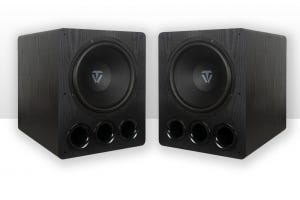
In part 1, we discussed the purpose and mechanisms of bi-wiring. While it may be a small difference, the simple technique can boost the performance of your sound system by reducing distortion in the audio signal. In the never-ending search for better sound, some people take this one step further with bi-amping.
In a bi-wiring setup, your speakers have two sets of positive and negative connections that join and connect to one amplifier. If you have two sets of cables connected already, why not use two amplifiers? That's exactly what bi-amping means -- sending your two sets of speaker cables separated by frequency to two separate amps. With this setup, one amp is handling the bass frequencies only (below the crossover point) and the other is handling the treble frequencies only (above the crossover point).
Why bi-amp?
So, what is the benefit of bi-amping? The main advantage of bi-amping over just bi-wiring is the addition of power into the system. While this may seem counterintuitive, you can't ever have too much power driving your speakers. Now, you can certainly have more power than you will ever feasibly need depending on the type of speakers you have, but having more than enough power is never a danger to the system. In fact, it's always a good idea to have some headroom in your power supply, because what can cause damage to your speakers is actually the opposite -- not enough power.
When you try to push your speakers to play too loud without a powerful enough amplifier, the amp can give out and send a clipped, or distorted, signal to the speakers. The distortion is what causes damage to the woofers. With enough power, the audio signal is sent clean through at any volume. Having a little extra power than what is required is a good idea because music (or any audio) is dynamic. You're not constantly using all the power you need to drive your speakers; songs have quiet parts and loud parts, and you can adjust the volume freely. Having enough power for those extra loud moments is having security for your sound system.
So, bi-amping is all about power. Now it's important to note the differences between passive and active bi-amping.
Passive bi-amping
This is by far the most common type of bi-amping. With passive bi-amping, you're still relying on the crossovers within the speakers to distribute the different frequency ranges to their corresponding drivers.
In this setup, just as with bi-wiring, symmetry is extremely important. Not only do you need to use identical cables, but you need identical amplifiers as well. If they are not the exact same model, they need to be the same brand with matching specifications in critical areas, like power output, impedance, and input sensitivity. If your amps have different specifications or are different models, you will be delivering different amounts of power to the high frequencies and low frequencies, which will totally disrupt the balance of the audio. Beyond that, there are a number of ways that different amps will perform differently even with the same speakers and audio signal, which makes it next to impossible to fully control and understand your system's performance. If you want bi-amping to work, you have to use matching equipment.
Active bi-amping
This type of bi-amping is much less common and can only be done with a select few brands. With active bi-amping, you use a separate electronic crossover that is connected ahead of the amplifiers. This crossover manages frequency distribution to the different amps, so each amp only receives one frequency range in the first place, and you can turn off the crossover in the speakers.
In this setup, you have more flexibility to use slightly different amplifiers, because the crossover can make level adjustments to balance out the differences. Again, there are very few speakers that allow active bi-amping. If you didn't buy your speakers with this setup in mind, then they probably aren't compatible.
Is bi-amping worth it?
If you want to know which of these performance-boosting methods is worth trying, it's bi-wiring, hands-down. All you need is a couple cables and you're good to go. With bi-amping, you need an entirely separate amplifier. This probably isn't worthwhile if you already have an amp that works well with your system.
Bi-amping can open up equipment options for those looking to invest in a system or upgrade, but the question still remains. Should you get two identical amps or one better amp for the same investment? It's usually better to go with a higher quality amp, but the benefits of bi-amping just depend on your individual needs.





